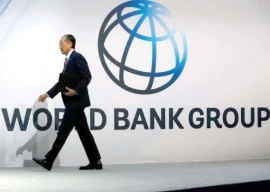
In an assessment released on its website on Thursday, Fitch - one of the three big credit rating agencies - said it revised the outlook because since the completion of Pakistan’s three-year International Monetary Fund (IMF) Extended Fund Facility in September 2016, there had been a partial reversal of gains made under the programme.
In particular, foreign currency reserves of the country have declined and fiscal deficit has widened.
Bond float not enough, Pakistan going to be IMF’s customer again
The IMF had provided a loan of $6.2 billion under the programme to help shore up Pakistan’s shrinking foreign currency reserves.
Though measures had recently been taken to address these trends, including some currency depreciation, tax rebates on exports and import duties on non-essential goods, these proved insufficient thus far to arrest the ongoing decline in reserves, Fitch said.
Moreover, political uncertainty and upcoming elections by July 2018 are likely to constrain the government’s ability to address them convincingly in the near term.
Fitch forecast that Pakistan’s overall reserves (including gold) would fall to $16.8 billion at the end of FY18 in June, which would cover 2.9 months of current account payments, after having peaked at $22.6 billion at the end of the IMF programme.
This forecast incorporates proceeds from the $2.5 billion worth of Sukuk and Eurobond issuances at the end of November 2017.
“The deterioration could be sharper in the absence of further currency flexibility and tightening of macro policies sufficient to restrain domestic demand,” Fitch said.
The decline in reserves is driven by a rise in the current account deficit, which widened to 4.1% of gross domestic product (GDP) in the fiscal year ending June 2017 from 1.7% in FY16. The deficit reflects rising capital imports for China-Pakistan Economic Corridor (CPEC) projects, higher energy prices, sluggish exports and loose macroeconomic policies.
Fitch expected a further modest widening of the current account deficit to 4.7% of GDP in FY18 on the basis of a pickup in exports and levelling off of imports following recent currency depreciation.
Elaborating, it pointed out that the decision of the State Bank of Pakistan (SBP) in early December to allow market forces to play a greater role in determining the exchange rate would, if implemented, relieve some of the pressure on Pakistan’s reserves and current account.
Immediately after the announcement, the rupee depreciated by nearly 5% against the US dollar, but the currency has been held stable since then and reserves have continued to slide in recent weeks.
“It remains to be seen how much flexibility the authorities will tolerate should there be sustained downward pressure on the currency,” Fitch remarked. Fiscal consolidation efforts in Pakistan suffered a setback last year, limiting progress on reducing the elevated public debt-to-GDP ratio.
The fiscal deficit surged to 5.8% of GDP in FY17 compared with 4.6% in FY16 and a revised target of 4.2%, driven by higher provincial government expenditures and an underperformance in revenues.
“The government views last year’s breach of the target as temporary and aims to return to a path of fiscal consolidation,” Fitch said.
It projected a decline in the FY18 deficit to 5% of GDP based on rising revenues and expenditure constraints, which would lead to a fall in the public debt ratio from 67.2% of GDP in FY17 to 66.8% in FY18.
Recent revenue performance has improved, but risks remain as the upcoming elections could limit near-term improvements to both revenue and expenditure.
‘IMF could impose non-economic conditions on Pakistan this time’
According to Fitch, Pakistan’s ‘B’ rating reflects a high public debt-to-GDP ratio, weak governance standards as measured by World Bank indicators, domestic political and security risks and a fragile external position, which are balanced by a relatively strong growth.
The rating also reflects that despite the rising external and fiscal pressures, Pakistan’s growth performance has continued to improve with annual GDP growth accelerating to 5.3% in FY17. This compares favourably with the ‘B’ country median of 3.5%.
Fitch forecast that the growth momentum would be sustained at 5.5% in FY18 and FY19, bolstered by recent investments under the CPEC initiative and reduced capacity constraints.
Published in The Express Tribune, January 26th, 2018.
Like Business on Facebook, follow @TribuneBiz on Twitter to stay informed and join in the conversation.


1727778647-0/diddy-(16)1727778647-0-165x106.webp)

1732014631-0/BeFunky-collage-(71)1732014631-0-165x106.webp)












COMMENTS (9)
Comments are moderated and generally will be posted if they are on-topic and not abusive.
For more information, please see our Comments FAQ